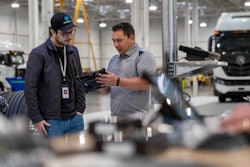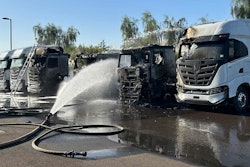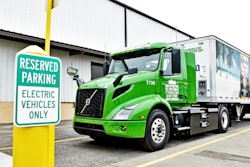I met a fleet manager with an operation headquartered in western Canada who reflected on the challenges of getting electricity at his office.
They had done the math and found that providing company cars with battery electric chargers made sense as a way to reduce cost. The challenge was that it was actually less expensive for them to power these chargers from an on-site generator running on natural gas versus getting grid power delivered to the facility. Completely eliminating emissions from their office transportation was not possible in this first step and they would need to be satisfied with making some progress toward that goal.
Technology purists love to jump on these types of examples to rationalize that battery electric vehicles do not make sense; invoking the term “greenwashing” as if some game of deception is occurring.
However, as I said, the fleet had done its homework, and the battery electric cars were a net cost reduction for them. The fact that the charging was done through a generator was a reality of the regional economics imposed by the utility in routing electric power in combination with the abundant supply of cheap, local natural gas. The fleet still found that its net emissions were less and their operating costs were less, so it was a tactical win versus doing nothing.
The concept of continuous improvement should be inherent in any commercial operation. The nature of the zero-emission transition is that it is not instantaneous. Fleets need to keep making the improvements they can make as they are possible and as they are feasible. If that means odd combinations of technologies — like my Canadian example — it still is taking steps in the right direction.
The critics of new technologies are constantly looking for factoids to disparage the new versus old. Change for these critics is unacceptable. It is easy to do nothing. It’s easy to complain. Psychologists label this as decision bias — the seemingly natural preference for the known versus the unknown.
Just a few short years ago, it was inconceivable that there would be production battery electric heavy- and medium-duty commercial vehicles. Yet here we are with multiple legacy OEMs and a raft of new manufacturers offering an extensive range of models which CALSTART estimates worldwide at more than 140 models from more than 40 manufacturers. A few years before that, it was inconceivable that a single automotive start-up would successfully be building 1 million battery electric cars per year. Yet here we are with Tesla producing more than that. Add to that Rivian, Polestar, other new vehicle manufacturers, and every legacy car maker that is on the path to producing production battery electric light-duty vehicles.
This is not the transportation industry’s first or last technology transition. Commercial transportation has been through multiple radical innovations and innumerable lesser technology evolutions. Not every one of those technologies was successful, but what is consistent is that commercial vehicle technology has rarely stood still. Change is inevitable. Obsolescence is similarly inevitable. Continuous improvement is how businesses survive – by taking little steps or big ones.
Fleets, whether large, medium or small, have to plan for the future. Read the announcements from vehicle makers. Manufacturers are telling us that they are ramping down production of fossil-fuel vehicles and ramping up zero-emission ones. Many OEMs have set goals between 2030 and 2045 when they will stop producing fossil-fueled vehicles. This is not just being driven by government regulations. These are business decisions to position their companies for the future.
Market penetration of technologies generally follow an S-shaped curve. At some point, the market takes off. For the automotive industry, I believe we are seeing that transition from gradual adoption to rapid market uptake of battery electric cars. A few years ago, sales of battery electric cars barely registered. The industry is now reporting 7% or more of new vehicles sold are battery electric. The International Energy Agency (IEA), estimates that 14 million EVs will be sold globally in 2023. Experian estimates that new EV car sales in the U.S. this year are about 7% of the total market. Look around you. EVs are no longer rare enough that you notice them. They are becoming ubiquitous.
Still, nay-sayers who used to point out that sales of vehicles were in the tens or hundreds of cars per year are finding solace in the fact that EV sales are now “only 7%.” The “yeah, buts” will likely still feel in the future that 10% or 20% of new vehicle sales will be inadequate to proclaim success of the technology. That is their prerogative.
The list of past major company brand names that did not adapt to a transportation technology transition is probably fodder for researchers to write lengthy technical papers: Pan American Airlines, Trans World Airline, American Locomotive Company (ALCO) — the second largest steam train manufacturer in the U.S., Baldwin Locomotive Works — the largest steam train manufacturer in the U.S., Lima Locomotive Works — bought Baldwin, Sterling Trucks, Marmon Trucks, Caterpillar on-road and vocational truck engines... These are just a few.
The point being that companies — especially big companies — need constantly to be adapting to technology changes to keep up with their markets. Waking up each day and doing the same thing doesn’t generally work out in the long run as a viable path to the future. Arguing against change is similarly only a short-term strategy. California and the Clean Freight Coalition reaching an agreement shows that manufacturers, industry groups and regulators can work toward zero-emission adoption applying continuous improvement approaches.
I am excited to see so many new names entering the U.S. heavy-duty truck market space. These are not just at the OEM level, but across the supply base. Competition is great for innovators. New companies are more able to try new paths. What do they have to risk? The legacy companies that stick to formulaic old practices and technologies are likely to get lost in the future market place.
A few years ago, leaders at two start-up truck manufacturers were alternatively claiming they could produce hundreds of thousands of heavy-duty EV trucks per year. It didn’t seem to bother anyone that the entire market for heavy-duty trucks was only a few hundred thousand trucks per year. While the numbers were inflated, the investing hype highlighted the reality that change was coming to commercial truck manufacturing and sales. Major legacy OEMs took notice and responded with their own zero- emission products.
I do expect new diesel trucks to be sold for the next few decades, but the numbers will invariably decrease with the years. The engineers and product sellers will find ways to keep the product alive amid stricter emissions requirements until the sales volumes or profit margins decrease to the point that it makes no economic sense to produce them. Some niche markets may never completely disappear.
Individual zero-emission products and manufacturers will also see failures. However, overall, the technology adoption trend for zero-emission vehicles, I firmly believe, will continue to gain market share. Fleets, from small to large, will need to keep adapting and taking steps forward rather than standing still. A retired chief financial officer from a major technology company teaching at a university once taught me that “if a business is not changing, it's dying.” Embrace change, even in little bits, to stay in the game.










